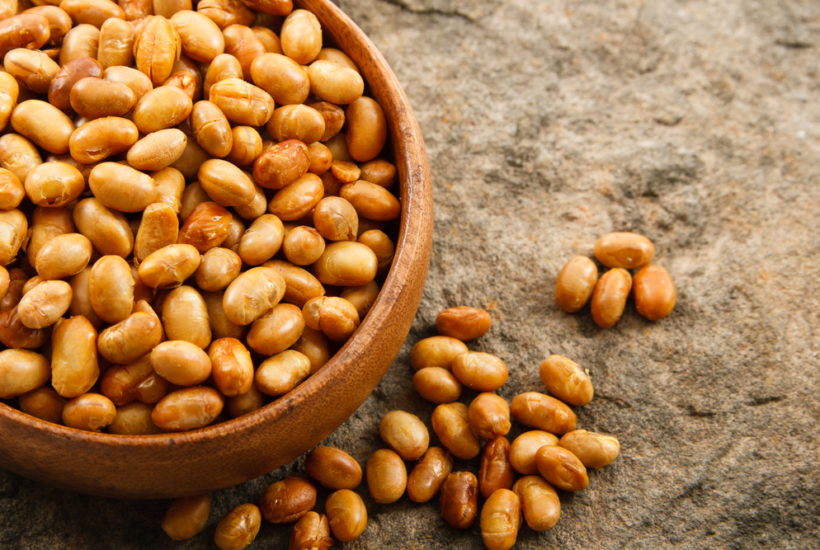Featured
Soybean market down as US-China trade deal remains unresolved
The soybean market is also worried about overall demand from China due to the Asian Swine Flu.

Wheat
Winter wheat markets were mixed, with winter wheat markets a little lower and Minneapolis spring wheat a little higher. Chicago HRW was the weakest market in response to the Kansas crop tour that found chances for very high yields. The Great Plains have seen a lot of rain and snow since last Fall, and crops have had plenty to drink. The rains should help produce great yields for winter wheat but also lower protein levels. The rains have helped to support spring wheat futures due to some increasing planting delays in the US. Canadian crops have also seen some planting delays due to cold and wet weather. US planting intentions were lower, and there could be further planted area losses this year if the weather does not start to improve soon.
Chicago SRW markets were also a little lower, but held the range from the previous week. The SRW crop saw some extreme cold over the winter and has seen a lot of precipitation so far this spring. There has been some talk of disease problems for the crop. Demand has been the big problem for any bullish traders for the last year and demand does not seem to be getting any better now. The demand is the past year has been disappointing as weaker prices have not improved sales. World prices have been stronger than those in the US due to less production in major world exporters such as Russia, Europe, and Australia. The outlook is for improved production this year so the chances for the US to sell a lot more wheat into the world markets are fading. The daily and weekly charts imply that overall price weakness will continue.
Corn
Corn was lower last week as demand for US corn has fallen off. The weekly export sales reports have shown less demand over the last couple of weeks, and the market is starting to anticipate increased competition in world markets for sales from South America. The USDA monthly supply and demand reports showed no reason to worry about supplies this year or next year. US and world ending stocks levels were estimated high and above trade expectations. USDA is estimating weaker pries for the coming year and the supply and demand estimates show no reason to doubt this. The market has been finding support from tight supplies and delayed planting progress. Producers have been unable to get much done in most of the Midwest. US weather remains cool and wet for most of the Midwest and further planting delays are expected. Yield potential will stare to drop now.
Brazil winter corn appears to be in good condition as the crop develops and moves to pollination. Crop estimates are high and have shown a tendency to increase as the crop develops. Most areas have seen enough rain for now. Corn prices are reported to be weakening in South America as the summer production from both Brazil and Argentina is now available. Meanwhile, the slow planting pace here and in Canada has supported oats futures.
Soybeans and soybean meal
Soybeans and soybean meal were lower last week. Soybeans trends are still down as the market has seen some extreme selling and very little buying interest in the last few weeks. The weekly charts for soybeans show the potential for futures to move to about 770 basis the nearest futures contract. Soybean meal trends are also down. The market is waiting for the trade deal with China, but worried about overall Chinese soybeans demand due to the Asian Swine Flu that has decimated the hog herd there. The government reports that at least 18 percent of its hog herd has been lost and private estimates show much higher loss potential. It is an indication of the very strong demand potential from China for hogs and pork and products and also an indication that soybeans and meal demand could be significantly less in the coming year as China works to eradicate the disease and then re-populate its herds.
The soybeans demand could take several years to recover as it will take time to rebuild the herds. President Trump announced increased tariffs on China last week but the two sides are still talking. China has aid it will retaliate but so far has not announced any new measures of its own. There had been ideas that an agreement could be reached this week when a Chinese delegation comes to Washington, but the US has accused China of trying to renegotiate on already agreed to measures and negotiations will now take longer.
Export differentials from the US and South America have been under pressure for this reason and also as the South American crop is now available. USDA released its monthly supply and demand estimates that also included a look at the coming production year. USDA indicates no shortages of soybeans anywhere, so prices are expected to remain relatively weak as sellers search for new buyers and everyone wonders just how strong the Chinese demand will be in the world market.
Rice
Rice was higher for the week and futures are now pushing to trade in the upper half of the trading range on the weekly charts. Ideas of planting delays in rice and continued good export demand have been reasons to support futures. Growing areas near the Gulf Coast and in Texas are mostly planted now, and initial development has been reported to be uneven. Some areas look very good while others have struggled to get good stands due to excessive rains. Planting progress has been more sporadic to the north due to cool and wet conditions, but some planting has been done. Ideas are that just under half of the total crop has now been planted.
The market seems content to trade in a wide trading range for now and this implies that somewhat higher prices are possible over the next couple of weeks. The domestic market is using price breaks to extend forward coverage as the mills push to own rice into the next harvest. Prices have been firm in Texas due to good demand for limited supplies. Much of the rice is moving to Mexico. Prices have been firm in Arkansas due to a lack of producer selling as they wait to get the next crop planted. Current supplies are high and bearish traders point to this fact as reason to keep prices relatively cheap or at least in a trading range. USDA showed big supplies for this year and also for next year and weak prices. However, the crop needs to get planted and to grow before the big supplies for the next production year can be assured. The delayed plantings should continue to support prices.
Palm oil and vegetable oils
World vegetable oils markets closed mixed last week. Palm oil was a little higher on better demand as shown by the private sources. MPOB released its monthly supply and demand estimates and the data was supportive to price3s. Demand was good and production was less than expected. That kept ending stocks less than trade estimates. Canola was firm last week after holding contract lows as supplies in the country remain high and demand has softened. The court case in which a Chinese national could be deported to the US on industrial espionage charges remains a major issue between Canada and China, and China has basically cut off purchases of Canadian canola due to the trial.
Canada is appealing to the US to help it solve the issue since the arrest was made at the request of the US government. The market has tried to become more stable in recent weeks, but faces strong headwinds in getting demand flowing again and avoiding big ending stocks. Worries that low production and low planted area this growing season have started to support new crop prices. Soybean oil was lower. US soybean oil faces increased competition in world markets from Argentina as its soybeans are harvested and processed. Argentina will look to reclaim its position as the largest exporter of soybean oil in the world.
Cotton
Cotton was lower as the lack of progress in the trade negotiations with China created a double slam for this market. Trends are down on the daily and weekly charts. The lack of a deal with China means less potential to sell US cotton there. China has bought in limited amounts from the US this year as it seeks to cover a short crop of its own. However, it has bought more from India and now can look to Brazil for supplies. The stock markets worked lower as there were some new fears about the world economic health, and that meant cotton futures moved even lower last week. The weekly export sales report showed weaker demand for US cotton. There is still expectations that the US can have strong sales with other major exporters starting to run low on supplies.
USDA showed that planting progress was good in its weekly crop updates last week, but USDA could report slower planting progress in the reports this week due to bad weather in much of the Delta and Southeast last week. Some rains have also appeared in western Texas. There are expectations that cotton planted area can increase this season as farmers could be attracted to cotton instead of grains such as corn or rice due to relative pricing. Anecdotal reports imply that industry is preparing for more production as new facilities are being opened. Cotton production is poised to make a comeback in the Delta and Southeast, and the wet weather implies less corn planted and more cotton or soybeans planted.
Frozen concentrated orange juice and citrus
FCOJ was higher and bounced after holding the recent contract lows on the charts. Trends are still down on the daily and weekly charts as the market looks at a big oranges crop and little demand for FCOJ. USDA cut its production estimate last week, but production is still estimated above 70 million boxes. That means that there should be no shortage of oranges available to the market to make FCOJ. Inventories inside the state are significantly higher than a year ago as Florida Citrus Mutual showed a 24 percent increase in state inventories in its weekly report.
The increase is coming from less demand and good imports along with the increased domestic production. The oranges harvest remains active in Florida as the new crop begins to develop. Producers are concentrating on harvesting Valencias and harvest progress should be strong. Fruit for the next crop is developing and ideas are that the next crop is off to a very good start. Production is very uniform so far this year and development throughout the state is about equal. Some fruit drop is being reported, but this is normal as the trees move to the next crop and drop the old fruit. Irrigation is being used frequently to help protect crop condition. Mostly good conditions are reported in Brazil.
Coffee
Futures were a little higher for the week in both markets as it looked like the funds were starting to cover some of the massive short position they have. New York is still in its recent trading range. Weakness in the Brazilian Real caused some speculative selling earlier in the week in New York, while reports of steady offers from Asia hurt Robusta in London. Futures are acting oversold, so further buying rally is possible at this time. The trade is still worried about big supplies, especially from Brazil and low demand. Brazil is dominating the market, and other exporters are having a lot of trouble finding buyers. Roasters were scale down buyers on the extended down move and now have more than ample supplies in house or on the way.
Prices are generally below to well below the cost of production for world producers, and prices are getting to that point for producers in Brazil and Vietnam. The inventory data from ICO and others shows ample supplies in the world market. Brazil had a big production year for the current crop, but the next crop should be less as it is the off year for production. Ideas are that the next crop might still be big as the weather has been good for the trees so far. Mostly dry conditions are in the forecast for this week. Cecafe said the country exported 2.976 million bags in April. Vietnam is active in its harvest and the export pace has been good so far this year.
Sugar
Futures were lower last week. The trade still is waiting for news of some kind to trigger a move out of trading ranges that have been mostly intact since late last year. Chart patterns on the weekly charts are sideways in New York and sideways in London. The fundamentals still suggest big supplies, and the weather in Brazil has improved to support big production ideas. CONAB estimated Brazil Sugar production at 34.1 million tons. Brazil weather is good in all areas as there is less rain in southern areas and more to the north. However, UNICA reported a slow start to the harvest season in the center-south area due to a lot of rain.
Brazil has been using a larger part of its Sugarcane harvest to produce ethanol this year instead of sugar, but Thailand has shown increased production this year. Ideas that production in India and Pakistan is being hurt, but wire services report bumper offers from India and Thailand in the White Sugar market. Very good conditions are reported in Thailand, but production this year could be less due to reduced area and low prices. Demand for Sugar has been good, and demand for ethanol is reported to be increasing.
Cocoa
Futures closed higher in New York and higher in London. New York closed will off the lows in both markets and actually near the highs after testing support on the weekly charts. Trends are still up in both markets. The main crop harvest should be about over and mid crop harvest is still a month or more away. Ivory Coast arrivals are strong as are exports. The weekly arrivals pace is about 15 percent higher than a year ago and is holding this level. Arrivals were reported strong in the rest of West Africa as well.
Demand appears strong and the market saw stronger than expected grind data when the quarterly grind is released in the EU, North America, and Asia over the next couple of weeks. Growing conditions are generally good in West Africa. Some early week showers and cooler temperatures were beneficial, and most in West Africa expect a very good mid crop harvest. Cameroon and Nigeria are reporting less production and prices there are reported strong. Conditions appear good in East Africa and Asia, but East Africa has been a little dry as has Malaysia.
—
DISCLAIMER: This article expresses my own ideas and opinions. Any information I have shared are from sources that I believe to be reliable and accurate. I did not receive any financial compensation for writing this post, nor do I own any shares in any company I’ve mentioned. I encourage any reader to do their own diligent research first before making any investment decisions.

-

 Cannabis1 week ago
Cannabis1 week agoMedical Cannabis vs Street Weed: Why Therapy Makes More Sense in 2025
-

 Markets23 hours ago
Markets23 hours agoGold, Liquidity, and Market Complacency Heading Into 2026
-

 Crowdfunding2 weeks ago
Crowdfunding2 weeks agoDeep Learning Italia Launches €400K Crowdfunding to Bridge Italy’s Tech Skills Gap
-

 Impact Investing1 week ago
Impact Investing1 week agoCOP30: Fragmented Climate Politics, Multi-Speed Transition, and Emerging Investment Opportunities
























